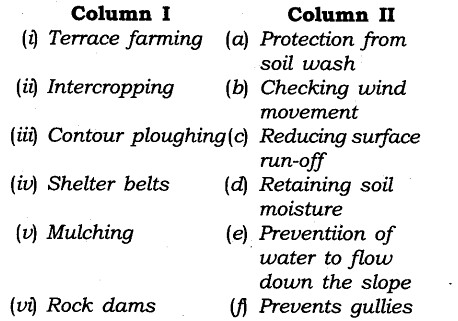NCERT CLASS 8 GEOGRAPHY CH 2
Land, Soil, Water, Natural Vegetation and Wildlife Resources
Question 1.
Answer the following questions.
(i) Which are the two main climatic factors responsible for soil formation?
(ii) Write any two reasons for land degradation today.
(iii) Why is land considered an important resource?
(iv) Name any two steps that the government has taken to conserve plants and animals.
(v) Suggest three ways to conserve water.
Answer.
(i) Temperature and rainfall are two main climatic factors responsible for soil formation. Rainfall contributes in breaking the rocks by applying pressure. Temperature fluctuations between hot and cold also form cracks in the rocks.
(ii) Reasons for land degradation are:
- Ever-growing demand of the growing population
- Destruction of forest 'cover
(iii) Land is an important resource because it provides surface for agriculture, living, forestry, industries, construction, etc. Most activities take place on land.
(iv) Steps taken by the government include establishment of natural parks and wildlife sanctuaries in different parts of India. Their purpose is conservation of vegetation and wildlife, respectively.
(v) Three ways to conserve water are as under:
- Rainwater harvesting: It is a method of collecting water while it rains so that it may come of use in the future.
- The canals used for irrigation should be properly built so that loss of water does not take place while the water is transported to the field.
- In dry regions, drip or trickle irrigation is suggested.
Question 2.
Tick the correct answer. (i) Which one of the following is not a factor of soil formation?
(a) time
(b) soil texture
(c) organic matter
(ii) Which one of the following methods is most appropriate to check soil erosion on steep slopes?
(a) shelter belts
(b) mulching
(c) terrace cultivation
(iii) Which one of the following is NOT in favor of the conservation of nature?
(a) switch off the bulb when not in use
(b) close the tap immediately after using
(c) dispose after shopping
Answer.
(i) (b), (ii) (c), (iii) (c).
Question 3.
Match the followings:
Answer.
(i) (c), (ii) (d), (iii) (a), (iv) (b).
Question 4.
State whether the given statement is true or false. If true, write the reasons.
- Ganga-Brahmaputra plain of India is an overpopulated region.
- Water availability per person in India is declining.
- Rows of trees planted in the coastal areas to check the wind movement is called intercropping.
- Human interference and changes of climate can maintain the ecosystem.
Answer.
- True
- True
- False
- False
Class 8 Geography Chapter 2 Land, Soil, Water, Natural Vegetation and Wildlife Resources Exercise Questions
Question 1.
Multiple Choice Questions Choose the correct option.
(i) Which of these resources covers about three-fourths of the total surface of earth?
(a) land
(b) soil
(c) air
(d) water
(ii) What are low-lying areas very susceptible to?
(a) earthquakes
(b) landslides
(c) flooding
(d) tsunamis
(iii) Which of these physical features are best suited for living?
(a) plains and river valleys
(b) mountains
(c) deserts
(d) lakes and rivers
(iv) Which of these is example of community land?
(a) the Sunder ban forests
(b) a bungalow
(c) the Parliament House
(d) none of these
(v) What is the majority of land in India used for?
(a) cultivation
(b) pasture
(c) forests
(d) none of these
Question 2.
Fill in the blank spaces given to complete each sentence.
- The percentage of fresh water on …………..
- The process responsible for soil formation is called ……………
- Private land is owned a fan ………………
- The grainy layer on land is called …………….
- Soil becomes fertile due to the right mix of …………… and ……….
- The color, texture, etc of soil is determined by ……………….
- Climate factors influencing rate of weathering include and …………….
- ………….. is the growing of different crops in alternate rows.
- 70% of fresh water exists as ……………..
Answer:
- 2.7
- weathering,
- individual
- soil
- minerals, organic matter
- parent rock
- rainfall, temperature
- intercropping
- ice sheets.
Question 3.
State whether each of the following statements is true (T) or false (F).
- The land has similar features all over the surface of the earth.
- Plains and valleys are densely populated because of soil fertility.
- Population and technology are important factors that determine land use pattern.
- The growing population is not a cause of soil erosion.
- Topography and organic material affect the soil composition of soil.
- Time affects the rate of humus formation during the process of soil formation.
- The earth is called the water planet because of the large amount of water available over it.
- Africa and West Asia are areas facing serious water scarcity.
- Forest and other vegetation promote surface run-off.
- The convention, CITES, lists species which should not be traded.
Answer.
- False
- True
- True
- False
- True
- True
- True
- True
- False
- True
Question 4.
Match the items given in Column I correctly with those given in Column II.
Answer.
(i) (c), (ii) (a), (iii) (e), (iv) (b), (v) (d), (vi) (f).
Comments
Post a Comment